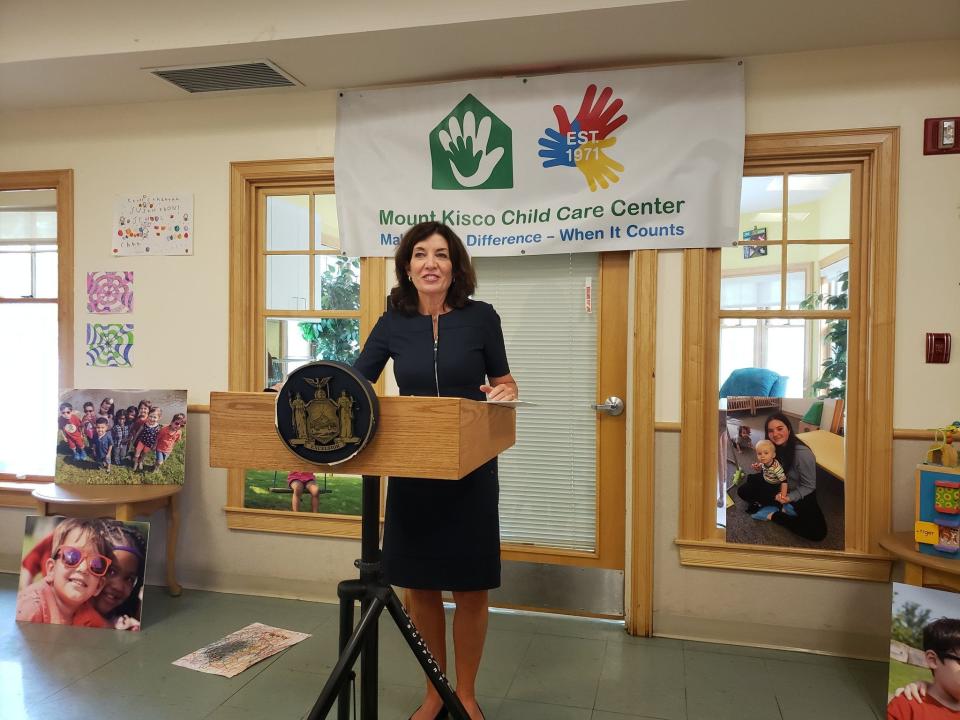NY's child care workers — and families struggling to afford care — need help | Opinion
The Child Care industry has been struggling for decades, and now it has reached a critical point. As the executive director of Mount Kisco Child Care Center and the co-president of the Westchester Early Childhood Directors Association, I have worked in this industry for more than 40 years and have witnessed firsthand the challenges it faces. The high cost of care and low teacher compensation have put the child care industry on the brink of disaster.
Like all industries, child care has been impacted by labor shortages. Historically lower wages and poor benefits of child care workers have presented a significant challenge as corporations like Target and Starbucks have raised hourly wages and improved their benefit packages to attract workers. Child care centers, with already razor thin margins and rising costs, have been unable to keep pace. Inflation pressures and other cost of living increases have made it difficult for teachers to afford to stay in their jobs. As a result, New York State’s child care work force has fallen 42%.
Meanwhile, child care has become unaffordable for most families, regardless of their income. In Westchester County, the average cost of care at a center is nearly $2,500 per month for one infant. Even middle and upper-middle-income families are struggling to pay the cost of care, which can be as much as college tuition or a mortgage.

Child care centers like MKCCC are struggling to provide high-quality care and education for all children in the community, regardless of their ability to pay the full tuition. The center operates as a non-profit and raises more than $600,000 per year to provide scholarships for middle and low-income earners. However, as inflation continues to rise and the need for child care grows, this is no longer enough to cover the cost of care for all of our scholarship families. The only guaranteed source of funding that comes into child care centers is from parent tuition.
When we calculate tuition, we look at the whole picture of the center and the need to provide consistent support for a family through their many years with us. Currently, the tuition in our infant program is $2,423 per month. When you calculate the actual cost of care, including ratios required by OCFS, for infant and toddlers, our actual cost of care in these younger years exceeds the tuition we charge. While we lose money on every infant and toddler in the program, we cannot charge the actual cost because it would price out families looking to enter our center and establish their plan for child care. To that end, we set our tuition lower than actual costs for those spots and make up the balance in the older programs knowing those children will eventually move into the older programs.
MKCCC operates as a nonprofit and accepts subsidized children as well. For each subsidized infant or toddler we receive only $1,636 per month. This means we fall short by $9,600 per year for every subsidized infant or toddler we accept and must separately raise funding to cover the shortfall. Reimbursement rates today are calculated based on market rates, not our specific tuition rates or the actual cost of care. That must change. If we did not operate as a nonprofit with the ability to separately raise funds to support these children we could not accept them. Subsidized care is also often linked to the hours that a parent works, underscoring the notion that child care is simply “babysitting.” Requiring parents to pick up their child, regardless of the child’s program schedule, is counter-productive to the benefits that an early education program can provide.
Child care centers provide rich learning environments that foster cognitive, physical, and social development, and teachers cultivate an environment of acceptance. They also prepare children for the many challenges they will face throughout their lives, teaching them resilience, perseverance, and the importance of being part of a community. But our fragile child care system is on the verge of collapse. Families cannot afford to pay more, and teachers cannot continue at their current rate of pay. This has made it more challenging to find quality child care for families at any income level.
New York must provide significant and sustained funding increases to provide livable wages to the child care workforce and support families who require financial assistance to pay for it. New York’s children, families, workforce, and companies will all benefit from this investment. Child care is an essential service and it is time for our society to recognize its value and invest in its future.
Dawn Meyerski is executive director of Mount Kisco Child Care Center and the co-president of the Westchester Early Childhood Directors Association.

This article originally appeared on Rockland/Westchester Journal News: NY child care workers, families need assistance

